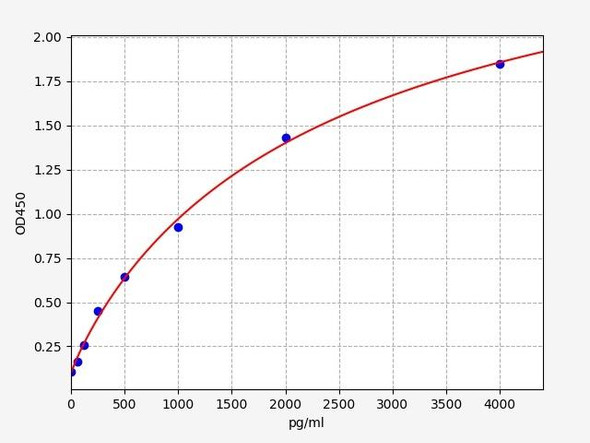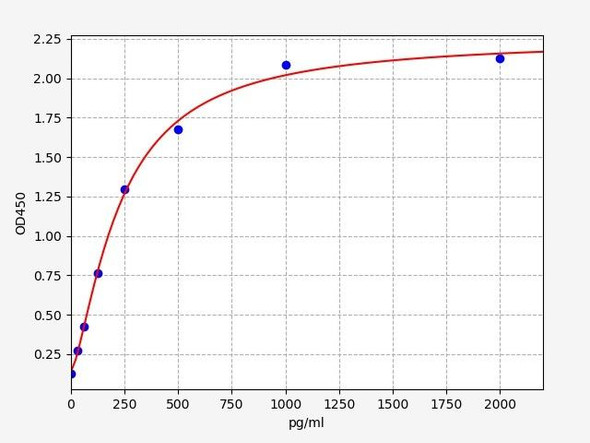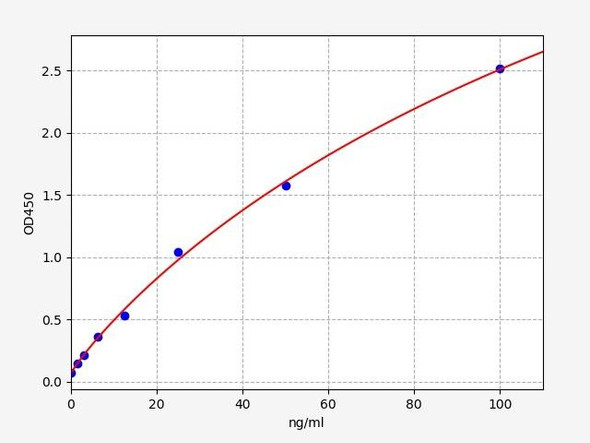Rat TGFBI ELISA Kit
- SKU:
- RTFI01165
- Product Type:
- ELISA Kit
- Size:
- 96 Assays
- Uniprot:
- P17246
- Sensitivity:
- 18.75pg/ml
- Range:
- 31.25-2000pg/ml
- ELISA Type:
- Sandwich ELISA, Double Antibody
- Synonyms:
- TGF-Beta1, Transforming Growth Factor Beta 1, TGF-B1, TGFB, TGFbeta, CED, DPD1, TGFBeta1
- Reactivity:
- Rat
Description
| Product Name: | Rat TGF-beta1 (Transforming Growth Factor Beta 1) ELISA Kit |
| Product Code: | RTFI01165 |
| Size: | 96 Assays |
| Target: | Rat TGF-beta1 |
| Alias: | TGF-beta1, Transforming Growth Factor Beta 1, TGF-B1, TGFB, TGFbeta, CED, DPD1, TGFbeta1 |
| Reactivity: | Rat |
| Detection Method: | Sandwich ELISA, Double Antibody |
| Sensitivity: | 18.75pg/ml |
| Range: | 31.25-2000pg/ml |
| Storage: | 4°C for 6 months |
| Note: | For Research Use Only |
| Recovery: | Matrices listed below were spiked with certain level of Rat TGF-beta1 and the recovery rates were calculated by comparing the measured value to the expected amount of Rat TGF-beta1 in samples. | ||||||||||||||||
| |||||||||||||||||
| Linearity: | The linearity of the kit was assayed by testing samples spiked with appropriate concentration of Rat TGF-beta1 and their serial dilutions. The results were demonstrated by the percentage of calculated concentration to the expected. | ||||||||||||||||
| |||||||||||||||||
| Intra-Assay: | CV <8% | ||||||||||||||||
| Inter-Assay: | CV <10% |
| Uniprot: | P17246 |
| UniProt Protein Function: | TGFB1: Multifunctional protein that controls proliferation, differentiation and other functions in many cell types. Many cells synthesize TGFB1 and have specific receptors for it. It positively and negatively regulates many other growth factors. It plays an important role in bone remodeling as it is a potent stimulator of osteoblastic bone formation, causing chemotaxis, proliferation and differentiation in committed osteoblasts. Homodimer; disulfide-linked, or heterodimer with TGFB2. Secreted and stored as a biologically inactive form in the extracellular matrix in a 290 kDa complex (large latent TGF-beta1 complex) containing the TGFB1 homodimer, the latency-associated peptide (LAP), and the latent TGFB1 binding protein-1 (LTBP1). The complex without LTBP1 is known as the'small latent TGF-beta1 complex'. Dissociation of the TGFB1 from LAP is required for growth factor activation and biological activity. Release of the large latent TGF-beta1 complex from the extracellular matrix is carried out by the matrix metalloproteinase MMP3. May interact with THSD4; this interaction may lead to sequestration by FBN1 microfibril assembly and attenuation of TGFB signaling. Interacts with the serine proteases, HTRA1 and HTRA3: the interaction with either inhibits TGFB1-mediated signaling. The HTRA protease activity is required for this inhibition. Interacts with CD109, DPT and ASPN. Activated in vitro at pH below 3.5 and over 12.5. Highly expressed in bone. Abundantly expressed in articular cartilage and chondrocytes and is increased in osteoarthritis (OA). Co-localizes with ASPN in chondrocytes within OA lesions of articular cartilage. Belongs to the TGF-beta family. |
| UniProt Protein Details: | Protein type:Motility/polarity/chemotaxis; Secreted; Secreted, signal peptide Cellular Component: axon; cell soma; cell surface; cytoplasm; extracellular matrix; extracellular space; microvillus; nucleus; proteinaceous extracellular matrix; secretory granule Molecular Function:antigen binding; cytokine activity; enzyme binding; glycoprotein binding; protein heterodimerization activity; protein homodimerization activity; protein N-terminus binding; protein serine/threonine kinase activator activity; punt binding; transforming growth factor beta receptor binding Biological Process: activation of NF-kappaB transcription factor; adaptive immune response based on somatic recombination of immune receptors built from immunoglobulin superfamily domains; aging; ATP biosynthetic process; cell activation; cell cycle arrest; cell migration; cell proliferation; cellular calcium ion homeostasis; chondrocyte differentiation; common-partner SMAD protein phosphorylation; defense response to fungus, incompatible interaction; endoderm development; epidermal growth factor receptor signaling pathway; epithelial to mesenchymal transition; evasion of host defenses by virus; female pregnancy; germ cell migration; gut development; heart development; hemopoietic progenitor cell differentiation; hyaluronan catabolic process; inflammatory response; inner ear development; intercellular junction assembly and maintenance; lipopolysaccharide-mediated signaling pathway; lung development; lymph node development; mammary gland development; MAPKKK cascade; membrane protein intracellular domain proteolysis; mitotic cell cycle checkpoint; mononuclear cell proliferation; morphogenesis of a branching structure; myelination; myeloid dendritic cell differentiation; negative regulation of blood vessel endothelial cell migration; negative regulation of cell cycle; negative regulation of cell differentiation; negative regulation of cell growth; negative regulation of cell proliferation; negative regulation of cell-cell adhesion; negative regulation of DNA replication; negative regulation of epithelial cell proliferation; negative regulation of fat cell differentiation; negative regulation of immune response; negative regulation of interleukin-17 production; negative regulation of mitotic cell cycle; negative regulation of myoblast differentiation; negative regulation of neuroblast proliferation; negative regulation of ossification; negative regulation of phagocytosis; negative regulation of protein amino acid phosphorylation; negative regulation of release of sequestered calcium ion into cytosol; negative regulation of skeletal muscle development; negative regulation of T cell activation; negative regulation of T cell proliferation; negative regulation of transcription from RNA polymerase II promoter; negative regulation of transcription, DNA-dependent; neural tube closure; neural tube development; Notch signaling pathway; oligodendrocyte development; organ regeneration; phosphate metabolic process; positive regulation of apoptosis; positive regulation of blood vessel endothelial cell migration; positive regulation of bone mineralization; positive regulation of cell migration; positive regulation of cell proliferation; positive regulation of cellular protein metabolic process; positive regulation of chemotaxis; positive regulation of collagen biosynthetic process; positive regulation of epithelial cell proliferation; positive regulation of exit from mitosis; positive regulation of fibroblast proliferation; positive regulation of histone acetylation; positive regulation of histone deacetylation; positive regulation of interleukin-17 production; positive regulation of isotype switching to IgA isotypes; positive regulation of MAP kinase activity; positive regulation of odontogenesis; positive regulation of peptidyl-serine phosphorylation; positive regulation of peptidyl-tyrosine phosphorylation; positive regulation of phosphoinositide 3-kinase activity; positive regulation of protein amino acid dephosphorylation; positive regulation of protein amino acid phosphorylation; positive regulation of protein complex assembly; positive regulation of protein import into nucleus; positive regulation of protein kinase B signaling cascade; positive regulation of protein secretion; positive regulation of regulatory T cell differentiation; positive regulation of smooth muscle cell differentiation; positive regulation of superoxide release; positive regulation of transcription from RNA polymerase II promoter; positive regulation of transcription, DNA-dependent; positive regulation of vascular permeability; protein amino acid phosphorylation; protein export from nucleus; protein import into nucleus, translocation; protein kinase B signaling cascade; receptor catabolic process; regulation of binding; regulation of cell growth; regulation of cell proliferation; regulation of DNA binding; regulation of gene expression; regulation of interleukin-23 production; regulation of MAPKKK cascade; regulation of protein import into nucleus; regulation of regulatory T cell differentiation; regulation of sodium ion transport; regulation of striated muscle development; regulation of transforming growth factor beta receptor signaling pathway; regulatory T cell differentiation; response to drug; response to estradiol stimulus; response to glucose stimulus; response to hypoxia; response to organic cyclic substance; response to organic substance; response to progesterone stimulus; response to radiation; response to vitamin D; response to wounding; salivary gland morphogenesis; SMAD protein complex assembly; SMAD protein nuclear translocation; T cell activation; T cell differentiation; T cell homeostasis; tolerance induction to self antigen; transforming growth factor beta receptor signaling pathway; ureteric bud development; vasculogenesis; ventricular cardiac muscle morphogenesis; wound healing |
| NCBI Summary: | binds the TGFbeta receptor; plays a role in regulation of cell growth and proliferation; induces synthesis of extracellular matrix proteins and may play a role in fibrosis [RGD, Feb 2006] |
| UniProt Code: | P17246 |
| NCBI GenInfo Identifier: | 135677 |
| NCBI Gene ID: | 59086 |
| NCBI Accession: | P17246.1 |
| UniProt Secondary Accession: | P17246,Q53YM8, |
| UniProt Related Accession: | P17246 |
| Molecular Weight: | 44,329 Da |
| NCBI Full Name: | Transforming growth factor beta-1 |
| NCBI Synonym Full Names: | transforming growth factor, beta 1 |
| NCBI Official Symbol: | Tgfb1 |
| NCBI Official Synonym Symbols: | Tgfb |
| NCBI Protein Information: | transforming growth factor beta-1; TGF-beta-1; transforming growth factor, beta-1 |
| UniProt Protein Name: | Transforming growth factor beta-1 |
| UniProt Synonym Protein Names: | |
| Protein Family: | Transforming growth factor |
| UniProt Gene Name: | Tgfb1 |
| UniProt Entry Name: | TGFB1_RAT |
| Step | Procedure |
| 1. | Set standard, test sample and control (zero) wells on the pre-coated plate respectively, and then, record their positions. It is recommended to measure each standard and sample in duplicate. Wash plate 2 times before adding standard, sample and control (zero) wells! |
| 2. | Aliquot 0.1ml standard solutions into the standard wells. |
| 3. | Add 0.1 ml of Sample / Standard dilution buffer into the control (zero) well. |
| 4. | Add 0.1 ml of properly diluted sample ( Human serum, plasma, tissue homogenates and other biological fluids.) into test sample wells. |
| 5. | Seal the plate with a cover and incubate at 37°C for 90 min. |
| 6. | Remove the cover and discard the plate content, clap the plate on the absorbent filter papers or other absorbent material. Do NOT let the wells completely dry at any time. Wash plate X2. |
| 7. | Add 0.1 ml of Biotin- detection antibody working solution into the above wells (standard, test sample & zero wells). Add the solution at the bottom of each well without touching the side wall. |
| 8. | Seal the plate with a cover and incubate at 37°C for 60 min. |
| 9. | Remove the cover, and wash plate 3 times with Wash buffer. Let wash buffer rest in wells for 1 min between each wash. |
| 10. | Add 0.1 ml of SABC working solution into each well, cover the plate and incubate at 37°C for 30 min. |
| 11. | Remove the cover and wash plate 5 times with Wash buffer, and each time let the wash buffer stay in the wells for 1-2 min. |
| 12. | Add 90 µL of TMB substrate into each well, cover the plate and incubate at 37°C in dark within 10-20 min. (Note: This incubation time is for reference use only, the optimal time should be determined by end user.) And the shades of blue can be seen in the first 3-4 wells (with most concentrated standard solutions), the other wells show no obvious color. |
| 13. | Add 50 µL of Stop solution into each well and mix thoroughly. The color changes into yellow immediately. |
| 14. | Read the O.D. absorbance at 450 nm in a microplate reader immediately after adding the stop solution. |
When carrying out an ELISA assay it is important to prepare your samples in order to achieve the best possible results. Below we have a list of procedures for the preparation of samples for different sample types.
| Sample Type | Protocol |
| Serum: | If using serum separator tubes, allow samples to clot for 30 minutes at room temperature. Centrifuge for 10 minutes at 1,000x g. Collect the serum fraction and assay promptly or aliquot and store the samples at -80°C. Avoid multiple freeze-thaw cycles. If serum separator tubes are not being used, allow samples to clotovernight at 2-8°C. Centrifuge for 10 minutes at 1,000x g. Removeserum and assay promptly or aliquot and store the samples at-80°C. Avoid multiple freeze-thaw cycles. |
| Plasma: | Collect plasma using EDTA or heparin as an anti-coagulant. Centrifuge samples at 4°C for 15 mins at 1000 — g within 30 mins of collection. Collect the plasma fraction and assay promptly or aliquot and store the samples at -80°C. Avoid multiple freeze-thaw cycles.Note: Over haemolysed samples are not suitable for use with this kit. |
| Urine & Cerebrospinal Fluid: | Collect the urine (mid-stream) in a sterile container, centrifuge for 20 mins at 2000-3000 rpm. Remove supernatant and assay immediately. If any precipitation is detected, repeat the centrifugation step. A similar protocol can be used for cerebrospinal fluid. |
| Cell Culture Supernatant: | Collect the cell culture media by pipette, followed by centrifugation at 4°C for 20 mins at 1500 rpm. Collect the clear supernatant and assay immediately. |
| Cell Lysates: | Solubilize cells in lysis buffer and allow to sit on ice for 30 minutes. Centrifuge tubes at 14,000 x g for 5 minutes to remove insoluble material. Aliquot the supernatant into a new tube and discard the remaining whole cell extract. Quantify total protein concentration using a total protein assay. Assay immediately or aliquot and store at ≤ -20°C. |
| Tissue Homogenates: | The preparation of tissue homogenates will vary depending upon tissue type. Rinse tissue with 1X PBS to remove excess blood & homogenizein 20ml of 1X PBS (including protease inhibitors) and store overnight at ≤ -20°C. Two freeze-thaw cycles are required to break the cell membranes. To further disrupt the cell membranes you can sonicate the samples. Centrifuge homogenates for 5 mins at 5000xg. Remove the supernatant and assay immediately or aliquot and store at -20°C or-80°C. |
| Tissue Lysates: | Rinse tissue with PBS, cut into 1-2 mm pieces, and homogenize with a tissue homogenizer in PBS. Add an equal volume of RIPA buffer containing protease inhibitors and lyse tissues at room temperature for 30 minutes with gentle agitation. Centrifuge to remove debris. Quantify total protein concentration using a total protein assay. Assay immediately or aliquot and store at ≤ -20 °C. |
| Breast Milk: | Collect milk samples and centrifuge at 10,000 x g for 60 min at 4°C. Aliquot the supernatant and assay. For long term use, store samples at -80°C. Minimize freeze/thaw cycles. |










